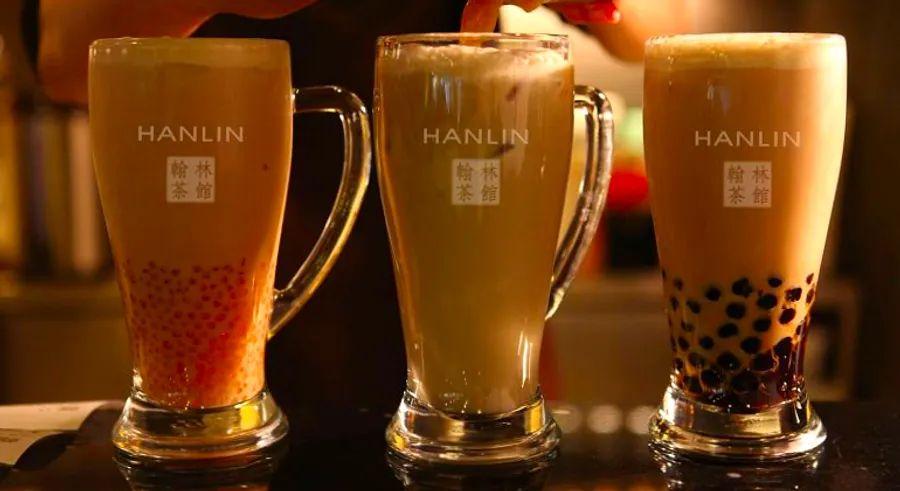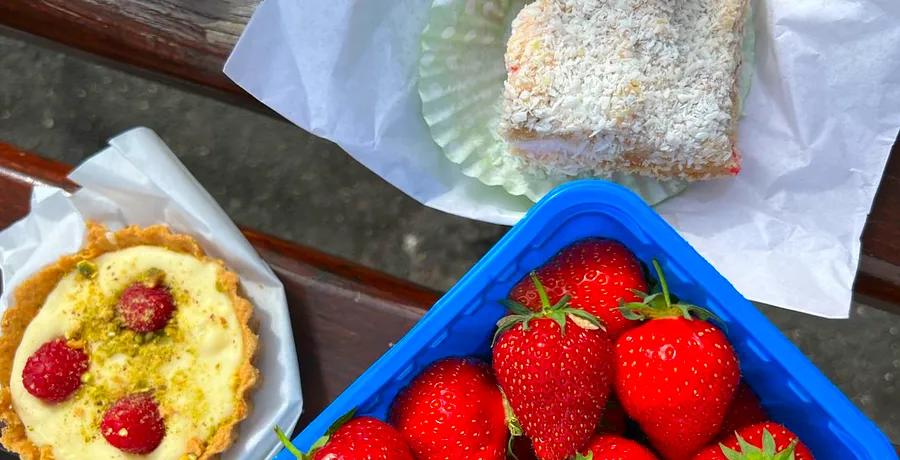The story behind bubble tea, one of Taiwan's most iconic drinks

What do a famous Hong Kong celebrity, a bankrupt businessman, and a failed military defense have in common?
Each played a role in the creation of bubble tea, the immensely popular Taiwanese drink that has exploded onto the global scene in recent years. And now, it’s making headlines again after Marvel actor Simu Liu accused a Canadian beverage company of cultural appropriation.
The controversy unfolded during an episode of 'Dragons’ Den,' a Canadian version of the ‘Shark Tank’-style reality show produced by CBC. During the show, two Quebec-based beverage entrepreneurs referred to bubble tea as a trendy, sugary concoction, admitting that customers often aren’t sure what’s in it.
Chinese-Canadian Liu, appearing as a guest star and potential investor, interrupted, saying, 'Hold on, hold on. I’m quite certain about its contents,' allowing them to finish before questioning their desire to 'improve' the drink.
Bubble tea has sparked controversy before, and this isn't its first time in the spotlight. In fact, the drink has been a topic of heated debate for decades.
It all began with foam tea.
Created in the 1980s, bubble tea (also known as 'black pearl tea' or 'boba tea') quickly became a beloved Taiwanese classic. While there are countless variations, at its core it’s a blend of tea, milk, and 'bubbles' – small, chewy spheres that can be made from everything from tapioca to fruit jelly.
So, where did this iconic drink actually start?
The origins of bubble tea can be traced back to the 1940s.
In 1949, after honing his skills as a mixologist at an izakaya in Taiwan during the Japanese occupation of WWII, Chang Fan Shu opened a tea shop where he began crafting a unique type of shou yao (hand-shaken) tea using cocktail shakers.
The result was a smooth, rich iced tea topped with delicate bubbles – a drink that quickly became known as 'foam tea' in Taiwan.
Today, shou yao is considered a cornerstone of bubble tea. No shou yao, no bubble tea.
This was a groundbreaking invention at the time – not only were cold drinks rare, but the idea of drinking for pleasure was just starting to take hold in post-war Taiwan. In the years that followed, the island’s love for refreshing cold beverages grew exponentially.
According to Taiwanese food historian Tseng Pin Tsang, 'The popularity of tea drinks went hand-in-hand with the rise of leisure dining in the 1980s, as Taiwan experienced rapid economic growth.'
"Alongside the growing market for pre-packaged industrial teas, there was a noticeable rise in street tea vendors and tea restaurants in suburban areas," says Tu Tsong He.
In 1986, the late Taiwanese artist and entrepreneur Tu Tsong He decided to launch a new business by capitalizing on the emerging tea shop trend.
"While visiting the Yamuliao wet market in Tainan, I came across fenyuan (tapioca balls), a childhood snack I’d always loved," Tu recalled in a 2020 interview with Dinogo.

"I thought, why not add fenyuan to my green tea? The translucent white balls with a pale center, when steeped in golden green tea, reminded me of my mother's pearl necklace," Tu reflected.
"That’s when I decided to name it 'zhen zhu lu cha' (pearl green tea)," he added.
Tu continued experimenting, adding larger, black tapioca pearls to milk tea for a richer flavor and chewy texture. This combination evolved into the iconic bubble milk tea that fans cherish today.
"The black tapioca balls were larger than the straws available at the time," Tu explained. "Our customers had to scoop the pearls out with spoons. To solve this, we worked with a plastic factory to design custom straws for our tea."
Tu's first bubble tea shop, Hanlin, opened its doors in October 1986, marking the beginning of the bubble tea revolution.
"Bubble tea quickly became a best-seller, and the steady profits from the tea shop helped me pay off my debts," Tu shared.
Today, Hanlin operates around 80 locations throughout Taiwan, with franchises spanning from the United States and Canada to mainland China.
But here's where it gets complicated: Tu wasn't the only one who claimed to have created bubble tea.
Lin Hsiu Hui, a product manager at the popular bubble tea chain Chun Shui Tang, says she invented the very first cup of bubble milk tea during a staff meeting in 1988.
On a whim, she added tapioca pearls she had brought into her Assam tea and tried it out, just for fun.

"Everyone at the meeting instantly loved the new drink, and within just a couple of months, it had outsold all of our other iced tea offerings," Lin recalled in a past interview with Dinogo Travel.
The staff at Chun Shui Tang also took credit for being the first to create foam tea, shaken up using a cocktail shaker.
As the years went on, the battle for bubble tea dominance became fierce. A lengthy legal dispute began in 2009, which finally came to a close in 2019 with a somewhat anticlimactic yet amicable resolution.
The court ruled that bubble tea is a beverage that anyone can prepare, making it unnecessary to argue over who originally invented it.
"We’ve all been in the tea business for a long time," Tu commented in 2020. "The legal battle with Chun Shui Tang was important for the sake of truth, but it’s not personal. Ultimately, it’s the tea drinkers who will decide."
Although the dispute over ownership didn’t have a clear victor, one part of bubble tea’s history remains uncontested: the story behind its iconic nickname, 'boba.'
Now commonly used to refer to bubble tea as a whole, the term "boba" originally described the large black tapioca pearls featured in the drink.
It is widely believed that the name was inspired by Hong Kong film star Amy Yip’s nickname, 'Boba,' which loosely translates to 'champion of breasts,' a playful reference that later became synonymous with the drink's defining ingredient.
The vendor named the larger black tapioca pearls "boba" to distinguish them from the smaller fenyuan commonly used in tea shops.
A true icon of Taiwan, bubble tea has become a beloved symbol of the island's culture.

But historian Tseng suggests there’s more to Taiwan’s devotion to bubble tea than just its unique taste and texture.
"It also captures the spirit of Taiwan during that time – a period when society was shifting from the old to the new," Tseng explained about the late 1980s.
"It blends Taiwan's traditional cultural experiences with a sense of nostalgia that resonates in today’s modern world," he added.
Tseng noted that in recreating two iconic elements – fenyuan and tea – Taiwan's society found a way to reconnect with its shared history and culture.
"Bubble tea stands as a prime example of reinventing traditional food. It has grown into a symbol of Taiwan’s pride and identity," Tseng emphasized.
In other words, Taiwanese take their bubble tea seriously – a lesson the island’s Defense Ministry learned the hard way.
In 2004, in an attempt to downplay the cost of a proposed weapons purchase, Taiwan’s Defense Ministry released a leaflet suggesting that if citizens skipped one bubble tea each week for the next 15 years, they'd save enough to cover the military expense.
The campaign was a disaster, sparking backlash and uniting bubble tea vendors and enthusiasts in opposition.
At a press conference, bubble tea chain Easy Way quipped, "Why not ask people to stop drinking Coke instead?"
Local media dubbed the incident the 'bubble tea for arms' controversy, with some scholars even suggesting it helped bubble tea gain international recognition.
Bubble tea 2.0

Today, bubble tea continues to innovate, with new flavors and textures constantly emerging.
A new wave of bubble tea shops are sprouting up around the globe, each putting their own twist on the beloved drink.
Taiwanese brand Tiger Sugar has introduced a fresh take with bubble-free drinks, featuring brown sugar-coated bubbles and fresh milk for a unique experience.
Newer bubble tea brands are getting creative by adding unexpected ingredients like Oreos, strawberries, and even sponge cake to their drinks.
Even long-established bubble tea shops have embraced innovation, expanding their menus with fresh ideas.
The bubble tea phenomenon has spread beyond Asia, with successful brands popping up around the world.
Bubbleology, one of the UK’s pioneering bubble tea chains, was founded by Assad Khan, a former British investment banker who first fell for the drink after trying it in New York's Chinatown in 2009. He opened his first shop in 2011.
Khan recalls his first bubble tea experience: 'It was a taro bubble tea, unlike anything I had ever tasted. The mix of textures—tea and chewy tapioca—was a whole new dessert experience,' he shared in an interview with Dinogo Travel in 2020.
The true beauty of bubble tea lies in how customizable it is—every element of the drink can be adjusted to your liking, which is something you won’t find in most other grab-and-go snacks.
Bubbleology, which began in the UK, has since spread to the United States, fully embracing the customizable essence of bubble tea with a vibrant range of colorful drinks.
While it's fun to experiment with different ingredients, the core of every great bubble tea remains the same: the tea itself.
The late Tu, who passed away in 2022 at 73, insisted on using only the finest Sri Lankan black tea, grown in Taiwan, for his bubble tea creations. It’s known for its rich fragrance and lasting aftertaste.
After Tu’s passing, tributes flooded in from friends and colleagues in the tea industry, who thanked him for his tireless efforts in promoting Taiwanese tea culture throughout his life.
In his final interview with Dinogo, Tu shared that his greatest joy in his career was traveling across Taiwan’s mountainous regions to discover the finest tea leaves.
He also emphasized, 'Bubble tea is not just the cornerstone and pride of Hanlin; it’s a flagship of Taiwan’s beverage industry. It introduces Taiwan to the world. So its significance extends beyond Hanlin to Taiwan itself.'

1

2

3

4

5
Evaluation :
5/5